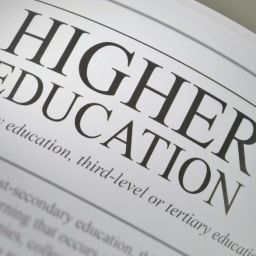

Dr. Frank Boyd
Frank was Provost and Academic Dean at Guilford College from 2017-2020 after serving as a faculty member and academic administrator at Illinois Wesleyan University (IWU). While there, he served in a variety of administrative positions including Department Chair, Director of General Education, Associate Dean, Associate Provost and Interim Provost.
The Challenges of Fewer 2025 High School Graduates
Thousands of colleges and universities across the country have spent their summer doing the same thing: tracking the students of the incoming class and adjusting their budget projections accordingly. It’s a summer tradition, when enrollment managers track the “summer melt” of students who’ve previously committed to attend, while also working very hard to convince late-deciders to join the incoming class. This whole process is attenuated by two challenges, one long-term and one short-term. In the long term, institutions will be dealing with the looming “demographic cliff,” which refers to the long-predicted decline in the number of high school graduates. This challenge will be exacerbated in the short term by a sharp decline in international student enrollment for the coming academic term due to abrupt shifts in immigration policy.
How will these two distinct but related processes affect colleges and universities? Also, what are schools doing to respond?
The Demographic Cliff, redux.
There’s little need to review the voluminous research that has forecasted the decline in prospective college students. That decline begins now, after the graduating high school class of 2025. Demographers and higher education policy makers have predicted the coming decline in college age students for at least two decades, and Nathan Grawe’s seminal work, Demographics and the Demand for Higher Education, provided the definitive analysis nearly eight years ago.
The magnitude of the decline and the budgetary implications became clearer as 2025 approached. The most recent review by the Western Interstate Commission on Higher Education (WICHE) provides another summary of the causes and likely implications of this demographic shift.
Some topline statistics provide a useful framing:
-
- Compared to 2023, the total number of high school graduates will fall more than 10% by 2041. 38 states will see a decline, with 12 states and the District of Columbia realizing a slight increase.
-
- The Midwest (16%), New England (17%), and West (20%) will suffer the greatest reduction in high school graduates.
-
- Two demographic groups will realize an increase in high school graduates, with Hispanic enrollment projected to increase by 16% over the next 15 years and multiracial students expected to increase a whopping 68%. Conversely, the percentage of white students in the graduating class of 2041 is expected to be 26% less than today.
Patrick Lane, Vice President at WICHE, summarizes the challenge for school leaders with the pithy observation that, “you can’t create 18-year olds out of nothing.” While obviously true, some scholars note that one path to address the precipitous drop in students is to, well, graduate more students from high school. The number of prospective college students is directly affected by the high school graduation rate, which has increased in recent years from 81.7% in 2012 to 86.3% in 2024.1 Policies and programs that would increase the retention of high school students (and therefore the number of graduates) would require significant investment in public secondary education, which is a policy path that Department of Education Secretary Linda McMahon has not advocated, thus far.
How international student enrollment amplifies the enrollment challenge
Even as institutions brace themselves for the demographic cliff, their enrollment challenges will be exacerbated by the rapid shifts in immigration policies from the Trump administration. Institutions have dealt with sharp decreases in international student enrollment in the past, with new international student enrollment dropping an incredible 72% between 2019 and 2020. Still, international students remain an important part of the enrollment strategy for many schools, and in recent years schools have eagerly recruited international prospects, with students from abroad now constituting 4% of total enrollment. Because international students often pay more in tuition and fees than domestic students, a sharp reduction in international enrollment will have an outsized impact on many schools. Their risk profile varies greatly, but some schools will face a stiff challenge. Leading this list is Illinois Tech, whose student body is 51% international students, and some more familiar names also appear in the top ten: Carnegie Mellon (44%), Columbia (40%), and Johns Hopkins (39%).
So how did the demographic challenges of higher education get so much worse so quickly? A number of key policy changes since January 20 are important. On May 27, Secretary of State Marco Rubio directed embassies to pause their review of student visa applications while guidelines were revised. After the pause, a stream of policy announcements followed, beginning with President Trump’s Executive Order on June 4 that sharply increases the scrutiny of visa applicants who would come to the United States to study. A policy directive from Secretary Rubio on June 18 articulated how the State Department would implement President Trump’s EO, stating that “we will conduct a comprehensive and thorough vetting, including online presence, of all student and exchange visitor applicants.” And to facilitate the review, visa applicants will “be instructed to adjust the privacy settings to ‘public’ on all their social media profiles.”
On May 28 Secretary Rubio announced more focused policies for Chinese students, instructing State Department officials to “aggressively revoke” visas of Chinese students enrolled in critical fields or with connections to the Chinese communist party. The effect of this policy alone could be significant, given that there were more than 270,000 Chinese students enrolled in US institutions during the 2023-24 academic term, representing 25% of all international students in the US.
We will not know the full implications of these orders until mid-September, when colleges conduct an enrollment census of their current students and we have a clearer sense of international student enrollment. The New York Times estimates that international student enrollment could drop as much as 30-40% for the incoming class. Analysts are already weighing in on the impact, and on June 30 Moody’s released a sector analysis that describes how a sharp reduction in international students could place significant financial stress on some institutions.
The curve on the demographic cliff just became much steeper.
How are institutions reacting to these challenges?
Colleges and universities are responding to the demographic challenges in a variety of ways. Interestingly, prior to January 20, one tactic to address the demographic cliff was to increase the recruitment of international students. The NAFSA Association of International Educators detailed some of the prospective efforts in a 2024 analysis. Clearly, that path will be much more difficult in the coming years.
Other institutions are implementing initiatives that will be familiar to experienced leaders in higher education, since they are ubiquitous strategic goals. The other common thread is that each of the following requires additional investments by the institution, which in a resource-constrained environment can be difficult.
-
- Increase retention. Scholars and practitioners have long emphasized holistic or intrusive advising as a crucial tool in retaining students and identifying attrition risks early. To defray the formidable start-up costs, some institutions feature reformation of the advising system in federal grant proposals, e.g. TRIO Student Support Services (notification for 2026 awards began in July); also, applications for Title III, Title V, and AANAPI-SI often include an advising component.
-
- Expand majors and degrees. There’s a bromide among academic administrators that restructuring a college curriculum involves all of the emotional challenges of moving a graveyard. Hyperbole? Yes, but institutional efforts to add new programs or restructure existing ones can be deliberate, at best, and potentially expensive. Still, many schools are adding new programs—both online and traditional—to attract post-baccalaureate students and to entice degree-completion students.
-
- Enhance recruitment in non-traditional markets. Many smaller institutions focus on traditional students with few resources devoted to identifying and recruiting non-traditional students. To do so would require investments, and some institutions establish partnerships with organizations like Inceptia, who can help identify non-traditional prospective students.
Is demography destiny?2 Maybe not, but addressing the long- and short-term challenges facing higher education will require new approaches that, in turn, will require additional resources. Successful efforts will undoubtedly identify extramural funding to fuel innovation.
Conclusion
Changes in the demography of college-aged students will require the attention of leaders in higher education, especially if the longer-term trends are attenuated by external shocks like the restrictive immigration policies that have been introduced in the last six months. The longer-term changes that will come from the demographic cliff will require structural adjustment of institutions with regard to recruitment, retention, and curricula.
The more recent challenges that are presented by shifts in immigration policy are difficult to predict. Leaders in higher education will need to implement immediate policy responses even as they help prepare their campuses for the longer-term demographic shifts.









